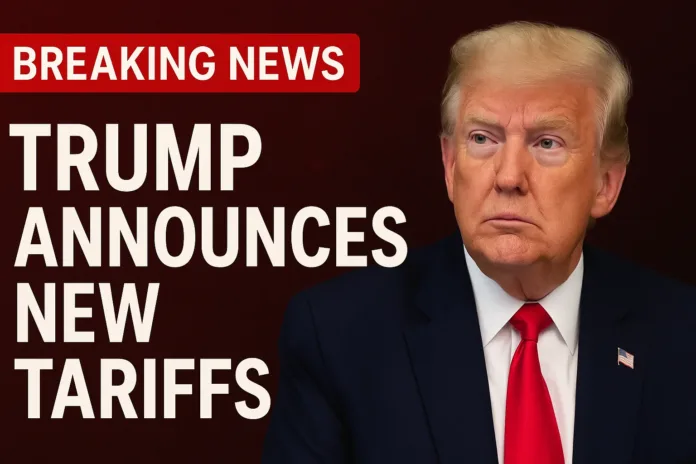The Article Tells The Story of:
- Trump hits Japan and South Korea with 25% blanket tariffs starting August 1
- Global tech firms brace for impact as supply chains face major disruption
- U.S. markets plunge after letters warn of tariff retaliation and trade barriers
- Squaredtech analyzes the ripple effect on chips, smartphones, and electronics
Trump Confirms 25% Tariffs Begin August 1
At Squaredtech.co, we follow policy decisions that directly impact technology, trade, and the global economy. President Donald Trump’s announcement to reimpose 25% tariffs on imports from Japan and South Korea marks a critical development that affects tech supply chains, global partnerships, and the financial markets.
Read More About Our Article of U.S. and China Cut Tariffs in 90-Day Deal That Shocks Global Markets Published on May 13th, 2025 SquaredTech
Here’s what we know about Trump’s tariff strategy, the letters he sent to foreign leaders, and the likely impact on U.S. businesses and consumers.
President Trump revealed on Monday that the United States will enforce 25% tariffs on all imports from Japan and South Korea beginning August 1, 2025. The announcement came via Truth Social, where he posted images of official letters addressed to Japanese Prime Minister Ishiba Shigeru and South Korean President Lee Jae-myung.
The tariffs mark a return to Trump’s “reciprocal trade” plan, originally introduced in April 2025, which proposed high tariffs to pressure trade partners into better deals. At that time, he had set tariffs at 24% for Japan and 25% for South Korea, but later lowered them to 10% after issuing a 90-day pause on April 9.
With Monday’s announcement, the full tariffs are coming back into force. Trump also signed an executive order to officially push the tariff implementation deadline from July 10 to August 1. According to White House press secretary Karoline Leavitt, the administration sent letters to 12 other nations and plans to notify more in the coming days.
How the Market Responded
News of the letters triggered a swift sell-off on Wall Street. U.S. markets dropped sharply:
- The Dow Jones Industrial Average fell by 447 points, down 1%.
- The S&P 500 slipped 0.8%.
- The Nasdaq Composite dropped 0.9%.
Investors reacted to fears of renewed trade tension, with particular concern about rising costs for goods and further pressure on global supply chains—especially in sectors like electronics, autos, and semiconductors. Squaredtech has observed similar patterns in past tariff cycles, where uncertainty quickly drags down sentiment across tech and manufacturing sector
Letters Warn Against Retaliation
Trump’s letters go beyond simply declaring tariff hikes. They also include strong warnings. If Japan or South Korea retaliates with their own import taxes, Trump says the U.S. will respond by adding the same percentage on top of the 25% base tariff.
The letters claim the tariffs are necessary due to “persistent U.S. trade deficits” with both countries. According to the U.S. Trade Representative, the U.S. had a $68.5 billion goods deficit with Japan and a $66 billion deficit with South Korea in 2024.
Trump has long viewed trade deficits as evidence that the U.S. is being treated unfairly, despite many economists arguing that deficits are not inherently negative and often reflect strong consumer demand.
In a notable clause, the letters say:
“If for any reason you decide to raise your Tariffs, then, whatever the number you choose to raise them by, will be added onto the 25% that we charge.”
The message is clear: the Trump administration is prepared to escalate if Japan or South Korea attempts to fight back.
Sector-Specific Duties and “Transshipping” Crackdown
Trump’s tariffs are not limited to broad categories. The letters specify that these 25% blanket tariffs are separate from sector-specific duties, meaning industries like electronics or autos could still face additional fees.
They also contain language targeting transshipping, a common strategy where goods are rerouted through third countries to avoid tariffs. Trump warns:
“Goods transshipped to evade a higher Tariff will be subject to that higher Tariff.”
This signals that enforcement will go beyond just paperwork—customs inspections and origin verification may increase, adding new burdens on importers.
At Squaredtech, we see this as a potential flashpoint for global manufacturers, especially those in the tech supply chain who rely on complex, multi-country shipping routes.
Impact on the Tech Industry
The 25% tariffs on Japan and South Korea are expected to hit the U.S. tech sector hard. These two countries are major exporters of high-value components, including semiconductors, display panels, memory chips, sensors, lithium batteries, and advanced robotics—core parts in devices ranging from smartphones to electric vehicles.
Manufacturers like Samsung, Sony, SK Hynix, LG Display, Panasonic, and Renesas serve as key suppliers for U.S. tech brands including Apple, Tesla, Nvidia, Dell, and HP. With higher tariffs, production costs for these U.S. firms will increase, and some may shift the burden onto consumers.
In the short term, hardware prices may rise, particularly for consumer electronics, smart home devices, laptops, and gaming consoles. Companies might accelerate plans to diversify their supply chains to countries like Vietnam, India, or Mexico—but that won’t happen overnight.
For startups, smaller manufacturers, and OEMs, the added cost could limit production and delay product rollouts. Investors may also pull back from hardware-heavy ventures due to market uncertainty.
Squaredtech expects some ripple effects in software development and app ecosystems as well, since hardware constraints can impact product roadmaps and user adoption cycles.
Trump Promises Tariff Adjustments Based on “Relationships”
While the tone of Trump’s letters is firm, he leaves room for change. If Japan and South Korea remove tariffs, non-tariff barriers, and trade restrictions, Trump says the U.S. will “perhaps” revise the new import tax levels.
One excerpt reads:
“These tariffs may be modified, upward or downward, depending on our relationship with your Country. You will never be disappointed with The United States of America.”
This flexibility could serve as a future bargaining chip. However, until either country takes action or enters talks, the 25% rate is set to remain in place.
Status of Other Trade Talks
After pausing reciprocal tariffs in April, Trump’s team promised 90 new trade deals in 90 days. So far, only three frameworks have emerged:
- A broad agreement with the United Kingdom
- A framework with Vietnam
- A preliminary deal with China
The Vietnam deal reportedly includes a 20% import tariff on Vietnamese goods and a 40% tariff on transshipped goods, while giving the U.S. tariff-free access to Vietnam’s domestic markets.
However, these deals are far from complete, and many trading partners remain uncertain. The lack of finalized agreements raises questions about how much leverage the U.S. really holds in ongoing negotiations.
What Squaredtech Expects Next
From a Squaredtech perspective, these tariff changes will likely impact:
- Consumer tech prices in the U.S. due to increased costs on imported components.
- Manufacturing delays as companies reconfigure supply chains to avoid tariffs.
- Global trade relationships, especially if Japan and South Korea respond with their own import duties.
As we track tech industry responses, we expect many firms to revisit sourcing strategies, supplier contracts, and contingency plans as August 1 approaches.
For U.S. consumers and tech businesses, the coming months could bring price shifts, shipping delays, and potential policy changes—depending on how trade talks progress and whether retaliation occurs.
Final Word from Squaredtech
President Trump’s decision to reintroduce 25% tariffs on Japan and South Korea imports is a high-stakes move with direct consequences for tech, trade, and everyday consumers.
At Squaredtech, we’re monitoring how these changes will affect device pricing, semiconductor access, and U.S. innovation. While the administration says these tariffs are about fairness and reciprocity, the global response—and the market impact—tell a more complicated story.
We’ll continue to cover each update as it happens. For now, mark August 1 on your calendar. That’s when the trade rules—and your next phone’s price tag—might start to look very different.
Stay Updated: Money Talks


